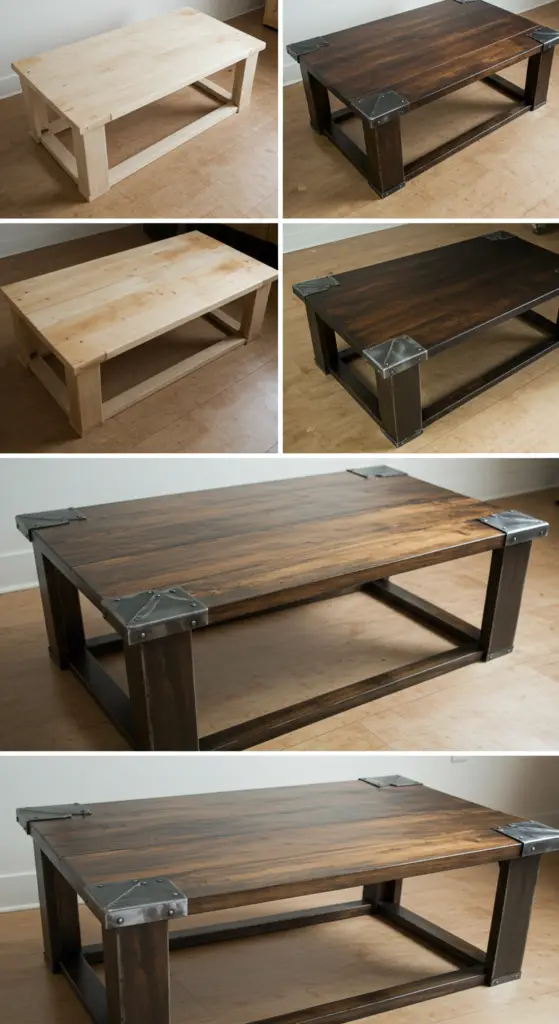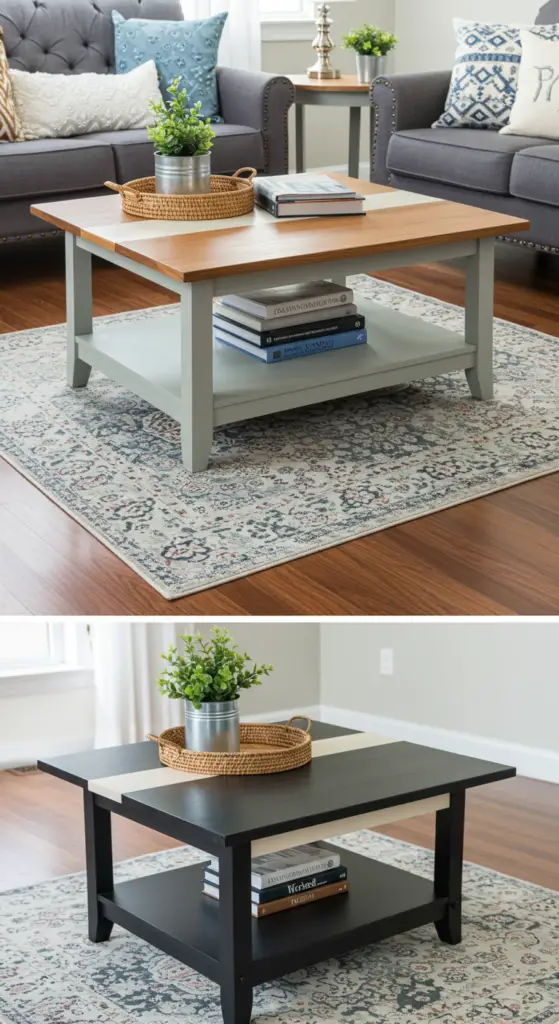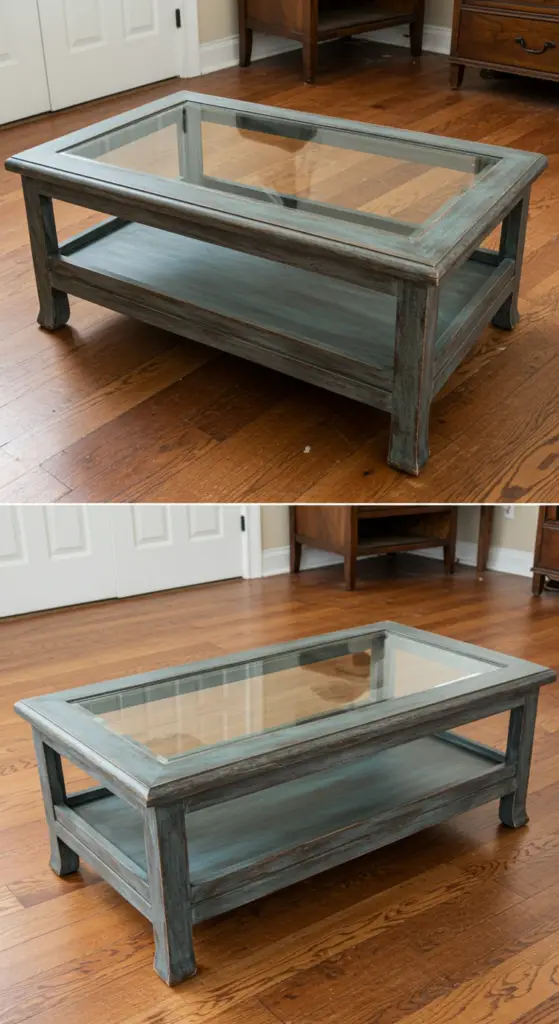As an Amazon Associate CoffeeXplore.com earns from qualifying purchases.
11 Easy DIY Coffee Table Makeover Ideas: Farmhouse & More
Is your living room begging for a refresh, but your budget is saying “no way”? A coffee table makeover might be the perfect solution!
A coffee table makeover is a budget-friendly and creative way to transform a central piece of furniture, giving your living room a fresh, new look without the expense of buying new. It allows for personalization and upcycling, turning an old or outdated table into a stylish focal point.
Having transformed dozens of tired pieces of furniture into stunning centerpieces over the past decade, I’ve learned that a little creativity can go a long way. This guide unlocks the secrets to eleven inspiring, easy-to-follow DIY coffee table makeovers, ranging from rustic farmhouse charm to sleek industrial chic. You’ll discover the essential tools, materials, and step-by-step techniques you need to achieve a professional-looking finish. Get ready to unleash your inner DIY enthusiast and breathe new life into your living space!
What Makes Coffee Table Makeovers Worth the Effort?
Coffee table makeovers are worthwhile because they offer a significant visual impact with minimal investment, allowing for personalized style expression and promoting sustainability through furniture upcycling.
Benefits of Upcycling Furniture
Upcycling furniture, like giving your coffee table a makeover, is incredibly beneficial for both your wallet and the environment. Instead of tossing out an old piece, you’re giving it a second life. This reduces landfill waste and the demand for new resources. A study by the Environmental Protection Agency (EPA) highlights that furniture waste is a significant contributor to landfills, making upcycling a responsible choice. According to the EPA, over 12 million tons of furniture waste were generated in 2018, with only a small fraction being recycled.
Cost-Effective Home Transformation
Think of the impact a coffee table has on your living room’s overall aesthetic. It’s often the centerpiece, tying the room together. A makeover can drastically alter the style and feel of the entire space, without the hefty price tag of a complete room renovation. You can achieve dramatic results with just a few cans of paint, some new hardware, or even repurposed materials. This is significantly cheaper than buying a brand-new, high-quality coffee table.
What Tools and Materials Do You Need?
The essential tools and materials for a coffee table makeover include sandpaper, primer, paint or stain, brushes, and a sealant, which collectively enable the transformation of the table’s surface and appearance.
Essential Tools for Coffee Table Makeovers
Before you dive into your project, gathering the right tools is crucial. Having everything on hand will streamline the process and help you achieve a professional-looking finish. Here’s a basic list:
- Sandpaper: Different grits (coarse, medium, fine) for preparing the surface.
- Screwdriver/Drill: For removing and reattaching hardware.
- Paintbrushes: Various sizes for different tasks (detailing, broad strokes).
- Paint Roller: For larger, flat surfaces.
- Drop Cloth: To protect your workspace.
- Painter’s Tape: For creating crisp lines and protecting areas you don’t want to paint.
- Wood Filler: For repairing any dents or scratches.
- Putty Knife: For applying wood filler.
Basic Materials Checklist
The specific materials you’ll need will depend on the type of makeover you choose. However, here’s a general checklist to get you started:
- Primer: To create a smooth, even base for paint.
- Paint or Stain: Your chosen color and finish.
- Sealant: To protect the finish and make it durable (polyurethane, wax, etc.).
- Cleaning Supplies: Soap, water, and a degreaser to clean the table before starting.
- New Hardware (Optional): Knobs, pulls, or legs to update the look.
What Are the Best DIY Coffee Table Makeover Ideas?
The best DIY coffee table makeover ideas include a range of styles like rustic farmhouse, industrial chic, and geometric designs, each offering unique aesthetics and techniques to revitalize an old coffee table.
1. Rustic Farmhouse Transformation

A rustic farmhouse transformation involves distressing the wood, applying a weathered finish, and potentially adding white-washed details to create a charming, aged look.
To achieve this look, start by sanding the coffee table to create a smooth surface. Apply a dark wood stain as a base. Once dry, use a dry brush technique with white or cream-colored chalk paint to create a weathered effect. Focus on edges and areas that would naturally show wear. Lightly sand again to reveal some of the dark stain underneath. Finish with a clear wax or matte sealant to protect the finish.
2. Industrial Chic Update

An industrial chic update typically combines dark wood stains with metal accents, creating a robust and modern look.
For an industrial vibe, consider using a dark wood stain, like espresso or walnut. You can add metal accents by attaching metal corner brackets or using metallic paint on the legs or edges. Consider adding hairpin legs or a metal base for a more dramatic transformation. A clear, satin-finish sealant will enhance the industrial aesthetic.
3. Painted Geometric Pattern Design

A painted geometric pattern design utilizes painter’s tape to create crisp lines and shapes, allowing for bold and modern color combinations.
This makeover requires careful planning. Sketch out your design beforehand. After priming the table, apply your base color. Once dry, use painter’s tape to create your geometric pattern. Apply your second (or third) color, ensuring clean lines. Remove the tape while the paint is still slightly wet to prevent peeling. Seal with a clear topcoat.
4. Coastal Whitewash Effect

A coastal whitewash effect involves applying a diluted white paint over a wood surface, creating a light, airy, and beach-inspired finish.
To achieve a coastal look, thin white paint with water (about a 1:1 ratio). Apply this mixture to the sanded coffee table, allowing the wood grain to show through. You can apply multiple coats for a more opaque finish. Consider adding nautical-themed hardware or rope accents for a truly coastal vibe. A matte sealant will maintain the casual, beachy feel.
5. Two-Tone Color Block

A two-tone color block involves dividing the coffee table into distinct sections and painting each section a different color, creating a modern and visually striking contrast.
This design is all about clean lines and bold color choices. Decide where you want to divide the table (top and legs, top and sides, etc.). Use painter’s tape to create a crisp line between the two sections. Paint each section with your chosen colors. A satin or gloss finish will enhance the modern look.
6. Antique Glass Insert Update

An antique glass insert update involves replacing or adding a glass panel to the coffee table top and applying an antiquing technique to the surrounding frame for a vintage aesthetic.
If your coffee table has an existing glass insert, you can simply clean it or replace it with a new piece. If not, you may need to create a recess for the glass. For the frame, consider using an antiquing glaze over a painted surface. This will create a worn, aged look.
7. Wood Stain Art Design

A wood stain art design uses different shades of wood stain to create intricate patterns or images on the coffee table surface, showcasing the natural beauty of the wood.
This technique requires some artistic skill. You can use stencils or freehand your design. Apply different shades of wood stain to create depth and dimension. A clear, satin sealant will protect the artwork and enhance the wood grain.
8. Decoupage Botanical Makeover

A decoupage botanical makeover involves applying cut-out botanical prints to the coffee table surface using decoupage medium, creating a nature-inspired and visually appealing design.
Choose your botanical prints (wrapping paper, napkins, or specialized decoupage paper work well). Cut them out carefully. Apply a thin layer of decoupage medium to the coffee table surface. Place the prints onto the medium, smoothing out any wrinkles. Apply several topcoats of decoupage medium, allowing each coat to dry completely.
9. Concrete Top Transformation

A concrete top transformation involves applying a thin layer of concrete over the existing coffee table top, creating a durable and modern industrial look.
This makeover requires careful preparation and working with concrete. You’ll need to create a mold around the existing tabletop. Mix and pour the concrete, ensuring a smooth and even surface. Allow the concrete to cure completely before removing the mold. Seal with a concrete sealant. This detailed guide from Family Handyman provides a step by step on the concrete process. Check out this comprehensive guide on creating a concrete countertop from Family Handyman.
10. Leather-Wrapped Edge Detail

A leather-wrapped edge detail involves adhering strips of leather to the edges of the coffee table, adding a touch of luxury and texture.
Measure and cut strips of leather to fit the edges of your coffee table. Use a strong adhesive, such as contact cement, to attach the leather. Clamp the leather in place until the adhesive dries.
11. Mosaic Tile Top Design

A mosaic tile top design involves creating a pattern or image on the coffee table surface using small tiles and grout, resulting in a unique and colorful piece.
Plan your mosaic design. Apply a thin layer of tile adhesive to the coffee table surface. Place the tiles onto the adhesive, following your design. Allow the adhesive to dry completely. Apply grout between the tiles, removing any excess. Seal the grout to protect it from stains. The Spruce offers a helpful article on choosing the right grout for your project. Learn more about choosing the right grout for your tiling project from The Spruce.
How Can You Ensure a Professional-Looking Finish?
Ensuring a professional-looking finish for a coffee table makeover requires meticulous surface preparation, including sanding and priming, and applying finishing techniques like multiple thin coats of paint or sealant.
Surface Preparation Tips
Proper surface preparation is arguably the most crucial step in any furniture makeover. It’s the foundation for a smooth, durable, and professional-looking finish.
- Clean Thoroughly: Start by cleaning the coffee table with soap and water to remove any dirt, dust, or grease. For stubborn grime, use a degreaser.
- Remove Hardware: Take off any knobs, pulls, or other hardware. This will make it easier to paint and prevent paint from getting on the hardware.
- Sand: Sand the entire surface to create a smooth base for the primer and paint. Start with a coarser grit sandpaper to remove any existing finish or imperfections, then move to a finer grit for a smooth finish.
- Fill Imperfections: Use wood filler to fill any dents, scratches, or holes. Apply the filler with a putty knife, and allow it to dry completely before sanding it smooth.
- Prime: Apply a coat of primer to the entire surface. This will create a uniform base for the paint, improve adhesion, and help prevent the old finish from bleeding through.
Finishing Techniques
The way you apply the paint or stain, and the final sealant, will significantly impact the overall look and durability of your makeover.
- Thin Coats: Apply multiple thin coats of paint or stain, rather than one thick coat. This will prevent drips and runs and create a more even finish.
- Sand Between Coats: Lightly sand between coats of paint or sealant with a very fine-grit sandpaper. This will create an ultra-smooth finish.
- Use the Right Tools: Use high-quality paintbrushes or rollers for a smooth application.
- Seal: Apply a sealant to protect the finish and make it more durable. Choose a sealant that is compatible with your paint or stain and the desired level of sheen (matte, satin, gloss).
FAQs About Coffee Table Makeovers:
How long does a coffee table makeover typically take?
A coffee table makeover can typically take anywhere from a few hours to a couple of days, depending on the complexity of the design and the drying time of the materials used.
What’s the best paint to use on a coffee table?
The best paint for a coffee table depends on the desired look and durability, but generally, chalk paint, milk paint, or acrylic latex paint with a sealant are excellent choices.
Can you makeover a glass-top coffee table?
Yes, you can makeover a glass-top coffee table by painting the frame, adding decorative elements underneath the glass, or even replacing the glass with a different material.
How do you prevent paint from peeling on a coffee table?
To prevent paint from peeling on a coffee table, ensure proper surface preparation by cleaning, sanding, and priming the surface before applying the paint, and finish with a sealant.
What’s the most durable finish for a coffee table makeover?
The most durable finish for a coffee table makeover is typically a polyurethane sealant, which provides a hard, scratch-resistant, and water-resistant surface.
Summary:
A DIY coffee table makeover is a fantastic way to revitalize your living space without breaking the bank. By exploring these eleven easy and inspiring ideas, from farmhouse chic to modern geometric designs, you can transform an old or tired coffee table into a stunning focal point. Remember, the key to a professional-looking finish lies in meticulous surface preparation and the careful application of your chosen finish. So, gather your tools, unleash your creativity, and embark on a rewarding DIY project that will breathe new life into your home! What style will you choose for your coffee table transformation?

